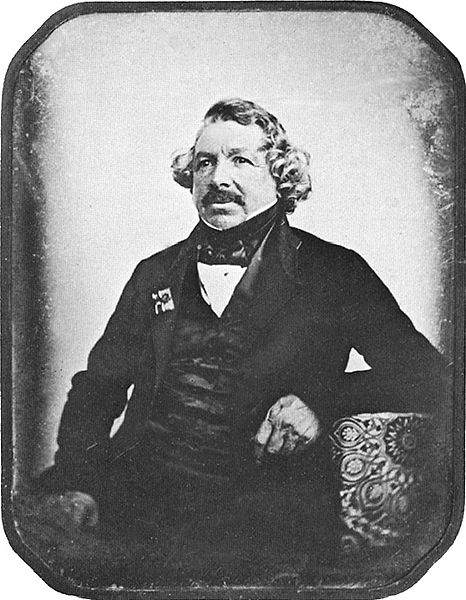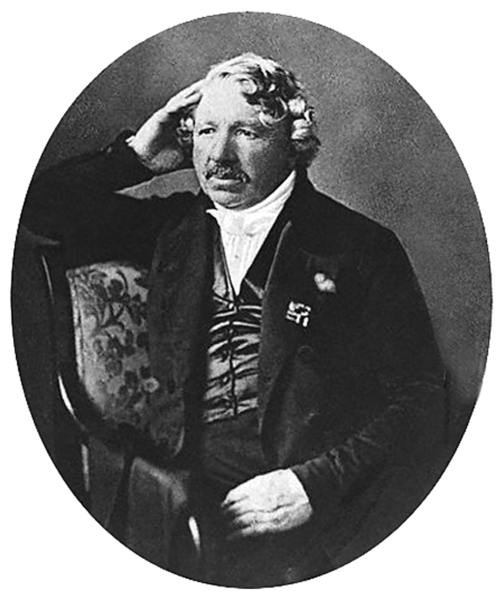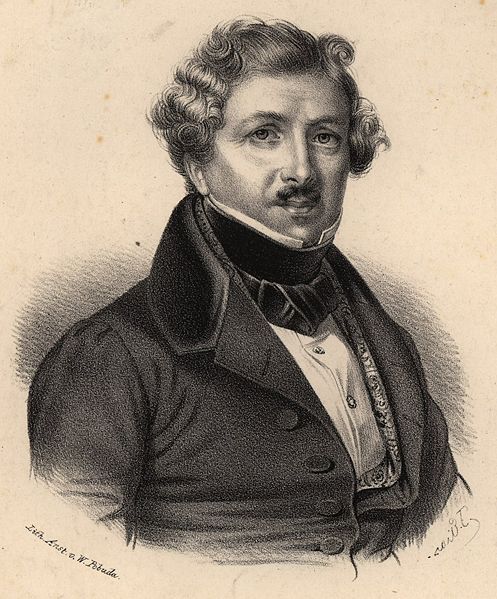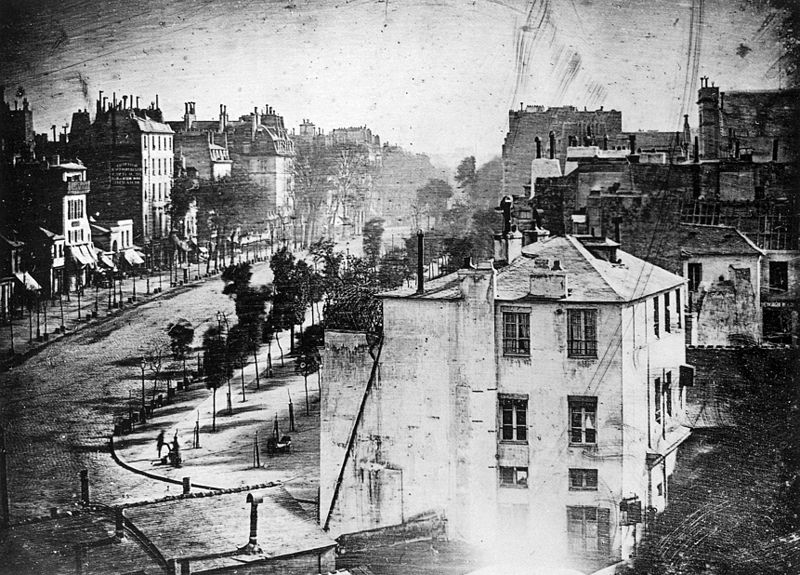<Back to Index>
- Explorer Adolf Erik Nordenskiöld, 1832
- Photographer Louis Jacques Mandé Daguerre, 1787
- Prime Minister of Italy Alfonso Ferrero, Cavaliere La Màrmora, 1804
PAGE SPONSOR


Louis-Jacques-Mandé Daguerre (November 18, 1787 – July 10, 1851) was a French artist and chemist, recognized for his invention of the daguerreotype process of photography.
Daguerre was born in Cormeilles-en-Parisis, Val-d'Oise, France. He apprenticed in architecture, theater design, and panoramic painting. Exceedingly adept at his skill for theatrical illusion, he became a celebrated designer for the theater and later came to invent the Diorama, which opened in Paris in July 1822.
In 1822 Joseph Nicéphore Niépce produced the world's first permanent photograph (known as a Heliograph). Daguerre partnered with Niépce three years later, beginning a four-year cooperation. Niépce died suddenly in 1833. The main reason for the "partnership", as far as Daguerre was concerned, might have been connected to his already famous dioramas. Niepce was a printer and his process was based on a faster way to produce printing plates. Daguerre perhaps thought that the process developed by Niepce could help speed up his diorama creation.
Daguerre announced the latest perfection of the Daguerreotype, after years of experimentation, in 1839, with the French Academy of Sciences announcing the process on January 7 of that year. Daguerre's patent was
acquired by the French Government, and, on August 19, 1839, the French
Government announced the invention was a gift "Free to the World." Daguerre
and Niépce's son obtained a pension from the Government in
exchange for freely sharing the details of the process. Daguerre died in Bry-sur-Marne, 12 km (7 mi) from Paris. A monument marks his grave there. The work on the Daguerre process was taking place at the same time as that of William Fox Talbot in England on the calotype process. Both men knew that they were working on a process that would revolutionize the art world. The Grand Tours which
were so popular were illustrated by drawings of scenes and the
"photographic" process would improve the quality and ease with which
these popular holiday memories could be produced. To
protect his own invention, Daguerre himself registered the patent for
Britain on August 12 (a week before France declared it "Free to the
World"), and this greatly slowed the development of photography in that
nation. Great Britain was to be the only place the patent was enforced. Antoine Claudet was one of the few people legally able to take daguerreotypes there. Daguerre did not need to make money from the invention to live, since he had been pensioned by the French government. Fox
Talbot spent a considerable amount of money on his process (est.
£5,000 in 1830s money) and licensed the process to British
photographers where it was used instead of the Daguerreotype. The first permanent photograph was made in 1826 by Joseph Nicéphore Niépce, building on a discovery by Johann Heinrich Schultz (1724):
a silver and chalk mixture darkens under exposure to light.
Niépce and Daguerre refined this process. Daguerre first exposed
silver-coated copper plates to iodine, obtaining silver iodide. Then he exposed them to light for several minutes. Then he coated the plate with mercury vapor heated to 75° Celsius, to amalgamate the mercury with the silver, finally fixing the image in salt water. These ideas led to the famous Daguerreotype. The
resultant plate produced an exact reproduction of the scene. The image
was laterally reversed -- as images in mirrors are -- unless a second
mirror was used during exposure to flip the image. The image could only
be viewed at an angle and needed protection from the air and
fingerprints so was encased in a glass-fronted box. Some ambrotypes were
passed off as Daguerreotypes by being placed in these type of boxes.
But the process was cheaper involving a weakly-developed glass card or
paper to appear as a positive. Tintypes also were "boxed" as Daguerrotypes. Daguerreotypes
were usually portraits; the rarer views are much sought-after and are
more expensive. The portrait process took several minutes and required
the subjects to remain stock still. Samuel Morse was
astonished to learn that Daguerrotypes of streets of Paris did not show
any humans, until he realized that due to the long exposure times all
moving objects became invisible. The time was later reduced with the
"faster" lenses such as the Petzval's portrait lens, the first mathematically calculated lens. In 1849, Daguerreotype images photographed by the famous Russian Photographer Sergei Lvovich Levitsky (1819
- 1898)
while on a mission to the Caucasus in 1843, were exhbited by the famous
Parisian optician Chevalier at the Paris Exposition of the Second
Republic as an advertisement of their lenses. Levitsky's use of the
Chevalier lens which used two cemented double lenses improved the
camera's focusing ability, thus reducing the time needed to capture an
image for portraiture and landscape photography. Levitsky's
Dageurreotypes would receive the Exposition's gold medal; the first
time a prize of its kind had ever been awarded to a photograph. The
Daguerreotype was the Polaroid of the day, producing a single image
which was not reproducible (unlike the Talbot process). Despite this
drawback, millions of Daguerreotypes were produced. By 1851, the year
of Daguerre's death, the Fox Talbot negative process was refined by the
development of the wet collodion process,
whereby a glass negative enabled a limitless number of sharp prints to
be made. These developments made the Daguerreotype redundant and the
process very soon disappeared.

